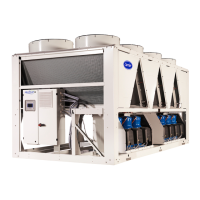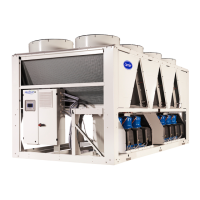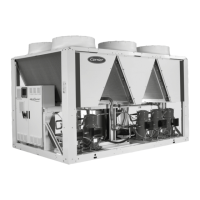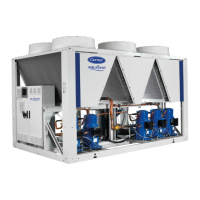30
To ensure the durability of pumps tted on the integrated
hydronic modules, the control algorithm of units in the range
includes protection against cavitation.
It is therefore necessary to ensure a minimum pressure of 60
kPa (0.6 bar) at the pump inlet both when shut down and during
operation.
A pressure below 60 kPa will prevent unit start-up, or will
cause an alarm and shut-down.
A pressure below 100 kPa will trigger an alert on the user
interface.
To obtain an adequate pressure, it is recommended:
• To pressurise the hydronic circuit between 100 kPa (1 bar)
and 400 kPa (4 bar) maximum at the pump inlet;
• To clean the hydraulic circuit during water lling or after
any modications are made;
• To regularly clean the screen lter.
Standard unit
All units are equipped as standard with a factory-set ow
switch. It cannot be adjusted on site.
The heat-transfer uid pump must be servo-controlled by the
assembly if the unit is not equipped with the hydronic module
option. Dedicated terminals are provided for installing the
heat-transfer uid pump servo control (to be wired on site).
Unit with hydronic module (option)
The "ow rate detection" functionality is handled by the
option via the pressure sensors.
Damage caused by frost is not covered by the warranty.
The plate heat exchanger, the pipes and the hydronic module
pump(s) can be damaged by frost. The components of the unit
(heat exchanger, pipes, hydronic module) will be protected by
following the recommendations below. Protection of the
remainder of the system is the responsibility of the installer.
The plate heat exchanger and all the components of the water
circuit can be protected against freezing by draining the entire
unit completely, checking that there are no retention points.
If this is not possible, the plate heat exchanger and all the
components of the water circuit can be protected against
freezing:
• Down to -20°C by heaters and heat trace cables (tted as
an option on the exchanger and internal pipe system)
supplied automatically (for units without the hydronic
module)
• Down to -20°C by heaters and heat trace cables (tted as
an option on the water type heat exchanger and internal
pipe system) supplied automatically and pump circulation
(for units with the hydronic module)
Never power off the heaters for the water exchanger and the
water circuit or pump, as they will no longer be providing frost
protection.
To ensure they continue to receive power, the main switch for
the unit or the customer's circuit and the auxiliary circuit
breaker for the heaters must be left closed (see the wiring
diagram for the location of these components).
To protect units with a hydronic module from freezing, water
must be circulated in the water circuit by the pump, which is
activated at regular intervals.
in standby mode.
Ambient unit temperature
range
30RBM/30RBP 160-520
without option 116 with option 116
> 0°C to 48°C - -
-20°C to 0°C Option 41
or
Suitable antifreeze
solution
(glycol, for example)
Option 42A
(1)
or
Suitable antifreeze
solution
(glycol, for example)
(1)
(1) Allow the pumps to circulate. If there is a valve, install a bypass (see diagram for winter position).
If the system is isolated by a valve, it is imperative to install a
bypass as indicated below.
Winter position
Unit
Water system
Closed
Closed
Open

